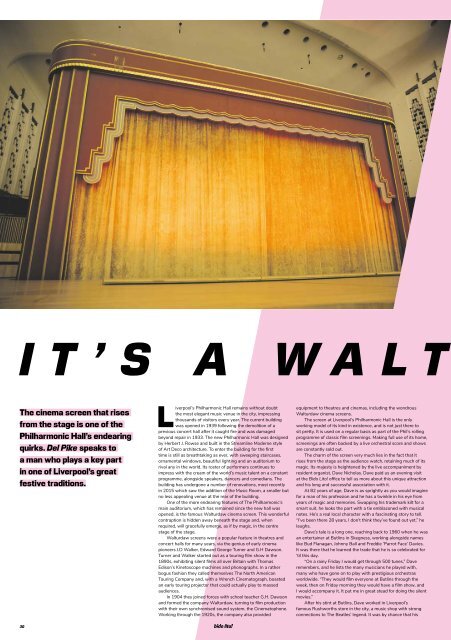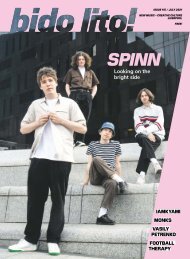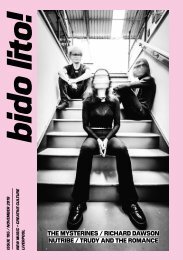Issue 84 / Dec 2017/Jan 2018
December 2017/January 2018 issue of Bido Lito! Featuring LO FIVE, TAYÁ, NICK POWER, MAC DEMARCO, LIVERPOOL MUSIC WEEK 2017 REVIEW and much more. Plus a special look at our need for space and independent venues, coinciding with a report into the health of Liverpool's music infrastructure.
December 2017/January 2018 issue of Bido Lito! Featuring LO FIVE, TAYÁ, NICK POWER, MAC DEMARCO, LIVERPOOL MUSIC WEEK 2017 REVIEW and much more. Plus a special look at our need for space and independent venues, coinciding with a report into the health of Liverpool's music infrastructure.
Create successful ePaper yourself
Turn your PDF publications into a flip-book with our unique Google optimized e-Paper software.
IT’S A WALT<br />
The cinema screen that rises<br />
from the stage is one of the<br />
Philharmonic Hall’s endearing<br />
quirks. Del Pike speaks to<br />
a man who plays a key part<br />
in one of Liverpool’s great<br />
festive traditions.<br />
Liverpool’s Philharmonic Hall remains without doubt<br />
the most elegant music venue in the city, impressing<br />
thousands of visitors every year. The current building<br />
was opened in 1939 following the demolition of a<br />
previous concert hall after it caught fire and was damaged<br />
beyond repair in 1933. The new Philharmonic Hall was designed<br />
by Herbert J. Rowse and built in the Streamline Moderne style<br />
of Art <strong>Dec</strong>o architecture. To enter the building for the first<br />
time is still as breathtaking as ever, with sweeping staircases,<br />
ornamental windows, beautiful lighting and an auditorium to<br />
rival any in the world. Its roster of performers continues to<br />
impress with the cream of the world’s music talent on a constant<br />
programme, alongside speakers, dancers and comedians. The<br />
building has undergone a number of renovations, most recently<br />
in 2015 which saw the addition of the Music Room, a smaller but<br />
no less appealing venue at the rear of the building.<br />
One of the more endearing features of The Philharmonic’s<br />
main auditorium, which has remained since the new hall was<br />
opened, is the famous Walturdaw cinema screen. This wonderful<br />
contraption is hidden away beneath the stage and, when<br />
required, will gracefully emerge, as if by magic, in the centre<br />
stage of the stage.<br />
Walturdaw screens were a popular feature in theatres and<br />
concert halls for many years, via the genius of early cinema<br />
pioneers J.D Walker, Edward George Turner and G.H Dawson.<br />
Turner and Walker started out as a touring film show in the<br />
1890s, exhibiting silent films all over Britain with Thomas<br />
Edison’s Kinetoscope machines and phonographs. In a rather<br />
bogus fashion they called themselves The North American<br />
Touring Company and, with a Wrench Cinematograph, boasted<br />
an early touring projector that could actually play to massed<br />
audiences.<br />
In 1904 they joined forces with school teacher G.H. Dawson<br />
and formed the company Walturdaw, turning to film production<br />
with their own synchronised sound system, the Cinematophone.<br />
Working through the 1920s, the company also provided<br />
equipment to theatres and cinemas, including the wondrous<br />
Walturdaw cinema screens.<br />
The screen at Liverpool’s Philharmonic Hall is the only<br />
working model of its kind in existence, and is not just there to<br />
sit pretty. It is used on a regular basis as part of the Phil’s rolling<br />
programme of classic film screenings. Making full use of its home,<br />
screenings are often backed by a live orchestral score and shows<br />
are constantly sold out.<br />
The charm of the screen very much lies in the fact that it<br />
rises from the stage as the audience watch, retaining much of its<br />
magic. Its majesty is heightened by the live accompaniment by<br />
resident organist, Dave Nicholas. Dave paid us an evening visit<br />
at the Bido Lito! office to tell us more about this unique attraction<br />
and his long and successful association with it.<br />
At 82 years of age, Dave is as sprightly as you would imagine<br />
for a man of his profession and he has a twinkle in his eye from<br />
years of magic and memories. Swapping his trademark kilt for a<br />
smart suit, he looks the part with a tie emblazoned with musical<br />
notes. He’s a real local character with a fascinating story to tell.<br />
“I’ve been there 28 years, I don’t think they’ve found out yet,” he<br />
laughs.<br />
Dave’s tale is a long one, reaching back to 1960 when he was<br />
an entertainer at Butlins in Skegness, working alongside names<br />
like Bud Flanagan, Johnny Ball and Freddie ‘Parrot Face’ Davies.<br />
It was there that he learned the trade that he is so celebrated for<br />
‘til this day.<br />
“On a rainy Friday I would get through 500 tunes,” Dave<br />
remembers, and he lists the many musicians he played with,<br />
many who have gone on to play with prestigious orchestras<br />
worldwide. “They would film everyone at Butlins through the<br />
week, then on Friday morning they would have a film show, and<br />
I would accompany it. It put me in great stead for doing the silent<br />
movies.”<br />
After his stint at Butlins, Dave worked in Liverpool’s<br />
famous Rushworths store in the city, a music shop with strong<br />
connections to The Beatles’ legend. It was by chance that his<br />
30


















